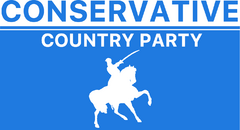User:Norcandy/Sandbox/C&C
Conservative & Country Party | |
|---|---|
 | |
| Abbreviation | C&C |
| Leader | Arthur Warwick |
| Chairman | Philip Fairfax |
| Founder | André Willemse (Conservative Party) Richard Somerset (Country Party) |
| Founded | June 1, 1878 |
| Preceded by | Conservative Party Country Party |
| Headquarters | O'Connell House, 27th September Road, Port Hope |
| Newspaper | The Clubhouse Report |
| Youth wing | Young Conservatives |
| Colors | Blue |
| House of Representatives | 84 / 152
|
| Senate | 45 / 96
|
| Province/territory governments | 4 / 8
|
| Province/territory legislative assemblies | 255 / 594
|
| Website | |
| www | |
The Conservative & Country Party is a Satavian centre-right political party that operates at all levels of governance in Satavia. It is one of the two major parties that have, since 1976, dominated Satavian politics alongside the Liberal Party.
The Conservative & Country Party's oldest predecessor, the Country Party, was established as a federal party to run in the 1816 Satavian general election by Richard Somerset. The party would ultimately win the election with a comfortable majority and would rule from 1816 until 1831, with a two-year interruption whilst Pieter Dandre and his Asteriaaner Nasionale party governed the country. The party would then spend the next fourteen years in opposition to the United Party (Satavia) before holding power for another ten years from 1845 until 1855. Donald Pienaar, the leader of the Country Party in 1855, had fallen ill and his illness contributed to their wipeout defeat at the 1855 general election. The Country Party would remain a minor force within Satavian politcs for the next fifty years, but would not achieve a majority in the Satavian parliament until the Crisis of 1906 ushered in Harry Goldmann who was elected in the March 1906 election but his massively instable government collapsed by November that year and he subsequently lost power to a big-tent coalition of opposing parties. The Country Party declined as a political force after this and later merged with the Conservative Party in 1911.
Meanwhile, the Conservative Party was formed by André Willemse in 1882 during a split within the Unionist Party. Originally lead by Willemse, he was swiftly ousted by a young naval commander by the name of Arthur O'Connell - whose charismatic leadership saw the Conservative Party take a landslide electoral victory in 1883. After O'Connell retired and was replaced by Lord Westenquay in 1901 the popularity of the Conservative Party quickly began to decline. After the party lost the 1903 election heavily, the party fell into electoral decline, and in 1911 merged with the Country Party.
The newly formed Conservative & Country party saw in the 1913 election and would become the third strongest party within the Satavian parliament for the next quarter of a century, but was never strong enough to dislodge either the Liberal party or the United party. Whilst the party was banned during the rule of the National party dictatorship from 1939 until 1976, it continued to operate illegally; and during the run up to the 1976 Satavian coup d'état, the party supported much of the Satavian Naval Service's high command. Although the Conservative & Country party was unable to dislodge the Liberal party during Eric Edwards and Leander Kokkinakis's stint as Prime Minister, the fallout from the Scott Affair was enough for the Conservative & Country party - lead by Ben De Villiers to seize power in the 1987 Satavian general election.